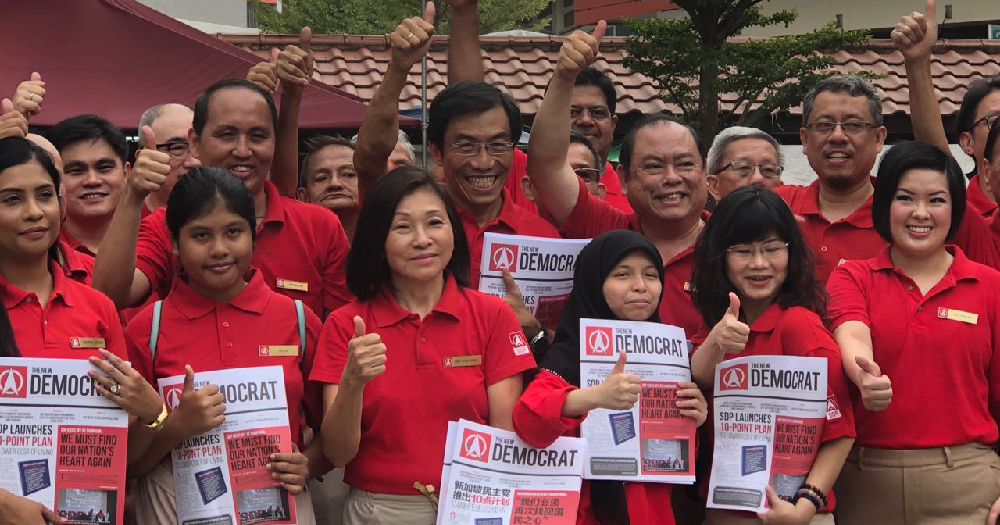On Apr. 28, the Singapore Democratic Party launched it's campaign for the upcoming general elections.
The campaign, "Four Yes, One No" (4Y1N campaign) spells out the party’s vision on how Singapore should recover from the Covid-19 pandemic.
Specifically the "Yeses" involve suspending Goods and Services Tax (GST), introducing retrenchment benefits, providing income for retirees, and putting people first.
The "No" concerns Singapore growing to a population of 10 million.
The SDP’s GE campaign follows up on the party's previous criticisms of the government policies regarding GST and population growth.
The 4Y1N campaign, said the party in a media statement, addressed the immediate necessities of Singaporeans during and after the Covid-19 pandemic, as well as ensuring that the longer-term challenges confronting the nation would be dealt with.
1) Yes to suspending GST
In their media statement, the SDP proposed cutting GST to zero per cent until the end of 2021.
“The GST is a regressive tax and will hurt the poor more than the rich,” said the party.
They added that suspension of the tax would stimulate the economy and help businesses, as “it is not smart economics” to raise the tax rate to 9 per cent.
The current rate of GST in Singapore is 7 per cent.
The government has previously announced that it will be raised to 9 per cent sometime between 2022 and 2025.
However, the raise would be preceded by a careful assessment of the “prevailing economic conditions as well as our needs at that point,” according to the Ministry of Finance, which previously hashed out the rationale for imposing GST.
2) "Yes" to paying retrenchment benefits
“SDP will fight for retrenchment benefits to be paid to workers retrenched as a result of Covid-19,” said the party.
This would involved a programme — deemed RESTART (Re-Employment Scheme and Temporary Assistance for the ReTrenched) — whereby a retrenched worker receives a progressively smaller portion of their last drawn salary over a period of one-and-half years.
This involves the government paying:
- 75 per cent of the last drawn salary for the first six months
- 50 per cent for the second block of six months
- 25 per cent for the last block of six months
3) "Yes" to providing income for retirees
The third "Yes" involves the SDP pushing for retirees over the age of 65 to receive a monthly income of S$500, a programme the party is calling the Retirement Income Scheme for the Elderly (RISE).
This will be extended to the “bottom 80 per cent of retirees, many of whom depend on their working children for financial support and especially those who do not have working children”.
The SDP said that the S$500 figure was derived from the Household Expenditure Survey, which showed that the average retiree household received close to that amount from their working children.
Therefore, according to the party, the scheme would also reduce the pressure on younger working generations.
Responding to queries from Mothership, SDP said the intent is for both RESTART and RISE to be legislated on a permanent basis.
4) "Yes" to putting people first
In its final "Yes", the SDP stated its intention to be a check on the People’s Action Party’s priorities.
The opposition party criticised the PAP for sacrificing public health by “insisting on calling for a GE” during the pandemic — a move that the SDP said was in line with political interests rather than the interests of public health.
There were also shots fired at the government’s initial policy of advising only residents with symptoms to wear surgical face masks and their inaction regarding the living standards of foreign workers.
5) "No" to 10 million population
The last element of the 4Y1N campaign involves the SDP decrying massive population growth and the consequential increase in population density.
The SDP also invoked the displacement of Singaporean workers by foreigners in its criticism of the government’s plan regarding the population.
“Imagine if the PAP gets its wish to jack the number up to 10 million by bringing in more foreigners,” said the SDP.
“Already, it cannot competently contain the outbreak of Covid-19 which spreads faster as the population density increases.“
A 2013 government white paper had previously projected Singapore’s population to hit 6.9 million by 2030.
According to The Straits Times, figures from 2019 indicated a population of 5.7 million.
The figure of 10 million was first proposed by former master planner Liu Thai Ker over a decade ago.
It was recently referenced by Deputy Prime Minister Heng Swee Keat in Mar. 29.
The Straits Times reported that Heng had cited Liu in a ministerial dialogue with students from Nanyang Technological University, urging them to remain open and understanding of foreigners.
Top image by Kayla Wong
If you like what you read, follow us on Facebook, Instagram, Twitter and Telegram to get the latest updates.
